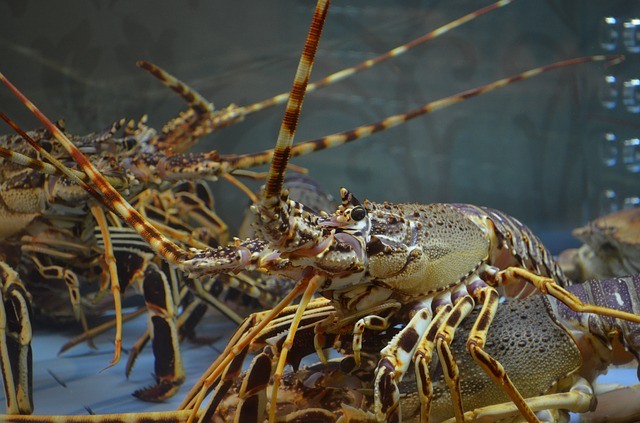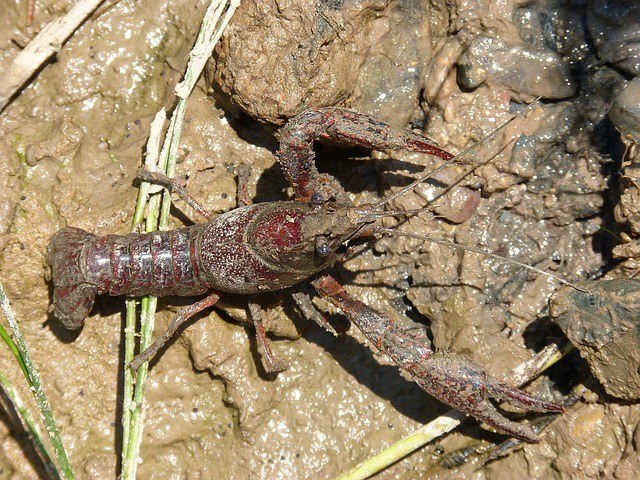Crayfish are small crustaceans that have similar features to lobsters, and are sometimes mistaken for lobsters (and vice versa).
In fact, crayfish are called a variety of different names, including crawfish, crawdads, yabbies (in Australia), mountain lobsters, freshwater lobsters, or mudbugs.
This can be admittedly a little confusing to someone who wants to acquire a pet crayfish, but it is very easy to distinguish between these two decapods.
Contents
The Rundown on Crayfish
Crayfish are much smaller than lobsters, measuring up to six inches at the most, while the average lobster can grow to be twenty inches or more.
The crayfish’s size makes it much easier to maintain. In the wild, they are normally found in freshwater streams or rivers, and may even be seen on land so long as they manage to keep their gills wet.
Their size, unusual appearance, hardiness, and adaptable diet have made them surprisingly famous pets nowadays. Of course, the fact that they are relatively easy to care for certainly helps!
On average, most species of crayfish live for two to three years in captivity, but, given a proper diet, attentive treatment, and suitable living conditions, it is possible for them to survive anywhere from seven to eight years.
They have similar needs to fish, so if you are looking to expand your fishkeeping skills, a crayfish may just be the right exotic pet to start off with.
Because their diet is so diverse, it may seem like you can just feed them anything, but crayfish will eat different foods depending on where they are bred and what stage of development they are at.
Below are just a few guidelines for how to properly feed your pet crayfish.
The Typical Crayfish Diet
Crayfish, whether in the wild or kept as a pet, are omnivorous scavengers. They typically eat whatever they can find, including any plants, fish food, or even other fish.
Always keep this in mind before you simply dump your pet crayfish in the same tank as your other pet fish, or the others could quickly become an unintentional dinner!
Crayfishes’ diets tend to differ depending on where they are raised. Knowing what crayfish eat in the wild, however, may help you plan out your own crayfish’s meals, too.
What Crayfish Eat in the Wild?
Wild crayfish tend to eat whatever they can grab with their claws. It helps that their natural environment is composed of mud, rocks, and a fast-flowing current, as they can scavenge for food trapped in the mud and rocks or simply catch whatever flows downstream.
This current also helps to wash away any pollutants that may build up in the water. If crayfish are exposed to polluted water for too long, it may prove fatal.
Their main diet consists of mostly dead fish, shrimp, or plants, as these are the food sources that are the easiest to scavenge. The decaying flesh or vegetation is also quite easy for them to rip apart with their claws. They will even eat rotting grass, twigs, leaves, insect larvae, and amphibian eggs.
If they are lucky, they may even snag a small live fish or tadpole, though this is typically difficult for them, due to the fact that they are not particularly strong swimmers and that their prey is much faster than them.
In especially desperate situations, they will even resort to cannibalism.
What to Feed Lobsters in a Tank
Of course, your very own pet crayfish will have a greater variety of foods to eat since you are able to choose their meal plans.
It is best to vary the foods at each feeding time so that they may receive all the proper nutrients they need to thrive.
Leftover Salads
Crayfish love eating decayed plant matter, so putting plants or old vegetables in their tank will help keep them fed.
Hornwort and java moss tend to be both nice decorative plants for your crayfish’s tank as well as nice sources of food that are able to survive within the tank itself.
Old or rotten leafy greens also tend to be popular treats, as they resemble the decaying plants they would eat in their natural habitat. Any leftover vegetables tend to work, too.
This will at least vary their meals a little and prevents your own food from going to waste. Crayfish will also feast on the algae in your tank, which helps to keep it clean.
Fish Food
Pellet foods are ideal food choices, as they are usually high in protein and quick to sink to the bottom of the tank, where your crayfish will reside.
You may also choose to feed them regular fish food but keep in mind that if this food does not sink to the bottom, your crayfish may not know it is there and grow hungry.
Be sure these types of food have enough calcium and iodine in them, as these nutrients are essential for crayfish to help them form new shells after they molt off the old ones.
If their old shell is left in the tank for too long, your crayfish may just eat that as well.
Meaty Delights
Live prey can also liven up an otherwise dull day for your crayfish.
You may feed them insects, worms, or other smaller fish or shrimp that will make them actively hunt for their food.
Different Foods for Different Ages
You will also need to know what foods are best for crayfish at each stage of their development. Crayfish, like most fish, start out as an oocyte, or an egg.
Once they hatch, however, they will quickly grow and resemble much smaller versions of your crayfish. This process typically takes about fifteen days, and your baby crayfish will reach about half an inch of growth.
Of course, due to their size, they may be hard to see at first. If you notice that your crayfish’s food supply is disappearing faster than usual, then you may have crayfish larvae in your tank.
Their small size also limits what they can eat. Therefore, if you know for sure that you have crayfish larvae, it is best to break down the food you give to them into much smaller pieces or find powdered food options to sprinkle into your tank.
Unfortunately, one of the biggest issues these larvae have, whether in the wild or in captivity, is the inability to find food.
Normally, crayfish larvae stay under their mother’s tail and eat the smaller pieces of food that float down to them, but sometimes they will want to venture out for themselves.
In that case, you should spread extra bits of food all throughout the tank to ensure that none of your crayfish larvae starve or turn and eat each other (yes, this includes the mother). Be sure to check that the food you spread is disappearing, and even watch them eat if you can.
Juvenile crayfish tend to look like smaller adults, and you may feed them the same foods that you would an adult crayfish.
Be sure to feed your crayfish larvae and juvenile crayfish every day so they have more energy to grow. The best foods to feed growing larvae and juvenile crayfish are a combination of vegetables and protein. Protein is especially important in younger crayfish diets, as they tend to be especially aggressive feeders.
When they do reach adulthood, however, crayfish become more relaxed. You can then feed them every other day. It is best to feed them less protein and more vegetables.
Older crayfish tend to steer more towards leafy greens than meat as they grow, but that does not mean you should cut meat out of an adult crayfish’s diet completely.
Please note that if you keep multiple crayfish in one tank and do not feed them properly, they may begin to fight amongst themselves and start eating each other. This may happen if you overstock your crayfish tank as well.
How Do Crayfish Eat?
As stated before, crayfish are not strong swimmers, so they usually wait for their food to sink to the bottom of their habitat before digging in.
They like to use their claws to tear up their food into smaller pieces that are easiest for them to ingest. They will mostly use their claws and their first two pairs of legs to pick up their food and eat it.
Their mouths are located underneath their antennae and are similar to the jaws of humans, only they open side to side instead of up and down. Their mandibles are actually very strong and can break the shells of other aquatic animals if need be.
Crayfish also like to burrow into rocks or thin layers of sand, as it gives them both a sense of security and a shelter for when they do not want to be out and about scavenging.
Therefore, to encourage their scavenging instincts, you should sprinkle their food throughout their tank during the day so that they may discover it at night when they are more active.
You can also train them to eat at certain points in the day if you keep feeding them at regular intervals. Crayfish will quickly catch on to when their feeding times usually are and are more likely to crawl out from their hiding spots when they know that food is coming.
Crayfish can get anxiety much like humans can, and, if they grow too anxious, they will go on a hunger strike, which usually leads to an early death.
To get them used to the tank, some people have taken to feeding their pet crayfish with tongs. This eases them into their tanks much more quickly and will help them get more used to people, too.
Here’s a video showing more details on keeping crayfish.
Do you have any tips on what to feed lobsters in a tank?




